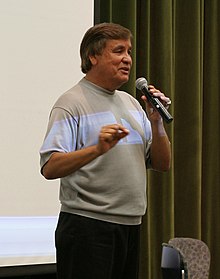Billy Mills
Billy Mills (actually: William Mervin Mills ; born June 30, 1938 in Pine Ridge , South Dakota ) is a former American long-distance runner and Olympic champion . His Indian name was Makata Taka Hela (respect the earth / land).
Life
Billy Mills belongs to the Oglala - Lakota - Sioux Indian tribe and grew up in the Pine Ridge Reservation . At age twelve he became an orphan and was sent to the Haskell Institute , a boarding school for Indians in Lawrence , Kansas . Here he first started boxing , but then switched to athletics and received an athletics scholarship from Bill Easton to the University of Kansas after being the Kansas high school champion in cross country for three years. Here he was American cross-country champion for 3 years (approx. 8 km). Easton favored extensive cross-country winter training (adapted to the cold Kansas winter) that Mills was used to, and unfamiliar intense interval training in the spring.
Upon graduation as a physical education teacher (BS), he became a lieutenant in the United States Marine Corps . He gave up running for a while, but then returned and qualified for the Tokyo Olympics in 1964 . With the Marines he also continued his training - mostly off-road - at Marine Corps Base Camp Pendleton , California (100 miles / week), as he was used to from Easton.
The favorite in the 10,000 meter run was the Australian Ron Clarke , the reigning world record holder. Also favored were Pyotr Bolotnikow from the Soviet Union and New Zealander Murray Halberg , 1960 Olympic champion over 5000 meters. Mills was practically unknown at the time. His personal best was about a minute slower than Clarke's.
The race was approached very quickly by Clarke. With two laps to go, only two runners could keep up with him, the Tunisian Mohamed Gammoudi and Mills. He overtook both of them on the last straight and won the race in a time of 28: 24.4 minutes, almost 50 seconds faster than his previous personal best. The hectic race was characterized by a multitude of laps and runners who were in the way . Siegfried Herrmann was particularly fair , who, lapped, made room for Mills at the start of the home straight, who was able to start his irresistible final sprint on lane 4. Mills caused the greatest sensation in these games. Since the weather in Tokyo was bad (plastic tracks only from 1968) and there were no preliminary runs, 29 athletes churned up the track over 25 laps. Cross-country runner Mills felt at home in this field . Mills also finished 14th in the Olympic marathon .
Mills later ran US records over 10,000 meters and over 3 miles , and a world record over 6 miles.
Billy Mills is 1.80 m and weighed 68 kg when he was active. His life was made into a film in 1984 ( Running Brave, with Robby Benson in the lead role). Together with Nicholas Sparks he wrote the book Wokini or The Search for Hidden Happiness (Wokini. A Lakota Journey to Happiness and Self-Understanding) in 1990 .
After leaving the Marine Corps, he worked as a freelance motivational speaker , was the honorary mouthpiece of the Running Strong for American Indian Youth , collected a. a. for Christian Relief Services more than US $ 200 million, was a member of the President's Council on Physical Fitness and Sports with Arnold Schwarzenegger . He became a Healthy American Fitness Leader in 1990 , was awarded the Distinguished Service Citation (University of Kansas) in 1993 , was inducted into the United States Olympic Hall of Fame , the United States Track and Field Hall of Fame, the National Distance Running Hall of Fame , Kansas Hall of Fame , inducted into the San Diego Hall of Fame, and National High School Hall of Fame .
literature
- Bill Mallon & Ian Buchanan: Quest for Gold. New York City 1984, ISBN 0-88011-217-4
- Ekkehard zur Megede: The Modern Olympic Century 1896-1996 Track and Field Athletics. Berlin 1999 (published by the German Society for Athletics Documentation eV )
Web links
- USA Track & Field Hall of Fame entry
- Short biography on Running Past
Individual evidence
- ↑ http://www.runningpast.com/billy_mills.htm on . August 25, 2016
- ↑ https://www.youtube.com/watch?v=jHYl8c7f5zU auf. 26th August 2016
- ↑ Arnd Krüger : Many roads lead to Olympia. The changes in training systems for medium and long distance runners (1850–1997) . In: N. Gissel (Hrsg.): Sporting performance in change . Czwalina, Hamburg 1998, pp. 41-56.
| personal data | |
|---|---|
| SURNAME | Mills, Billy |
| ALTERNATIVE NAMES | Mills, William Mervin |
| BRIEF DESCRIPTION | American long-distance runner and Olympic champion |
| DATE OF BIRTH | June 30, 1938 |
| PLACE OF BIRTH | Pine Ridge, South Dakota , South Dakota |
